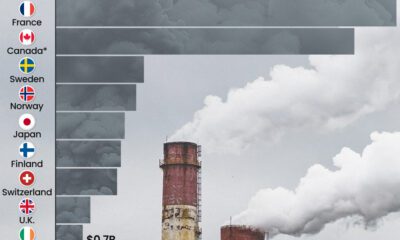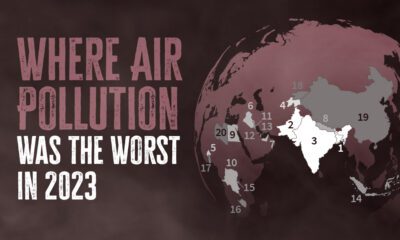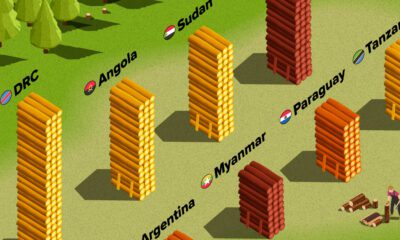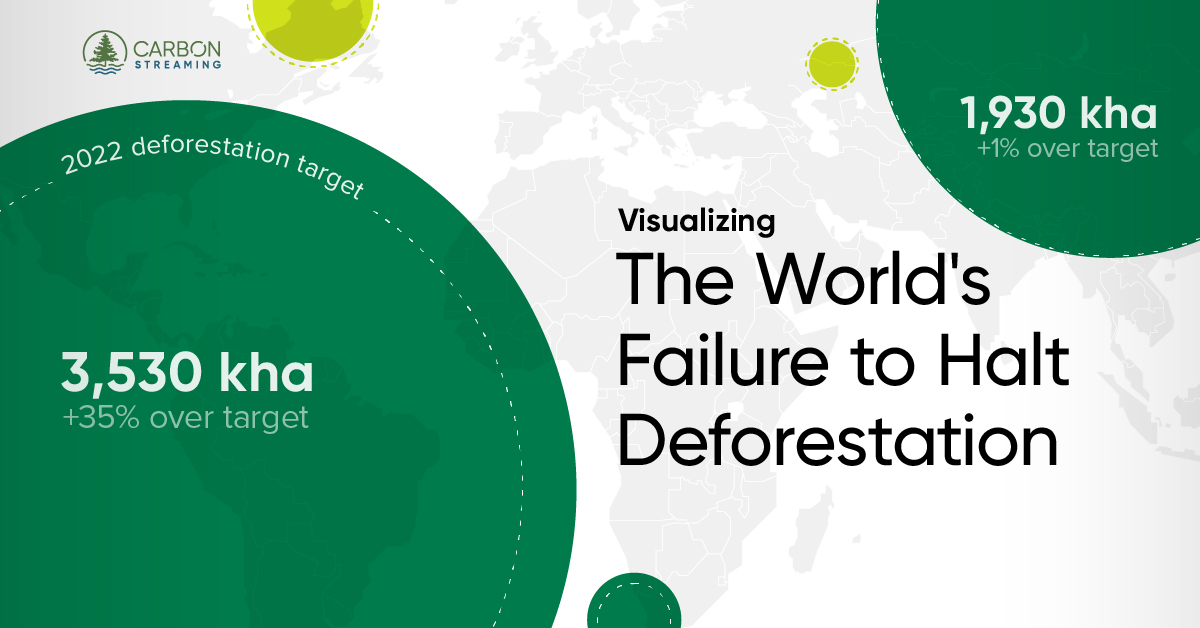Visualizing The World’s Failure to Halt Deforestation
Visualizing The World’s Failure to Halt Deforestation
Global deforestation in 2022 rose by 4%, reaching 6.6 million hectares. This number is 21% higher than the 2022 target needed to end deforestation by 2030.
In this map, our sponsor Carbon Streaming examines the failure to reduce deforestation in certain regions around the globe, based on data from the Forest Declaration Assessment.
Most Deforestation Occurs in Tropical Regions
In 2022, deforestation alone accounted for around 7% of global greenhouse gas emissions.
Nearly 96% of global deforestation took place in tropical regions in 2022. The loss of tropical primary forests reached 4.1 million hectares, 33% higher than the needed trajectory to halt primary forest loss by the end of the decade:
| Region | Deforestation 2022, in thousand hectares (kha) | Target for 2022* (kha) | Deviation from target |
|---|---|---|---|
| Tropical Africa | 820.0 | 650.0 | +26% |
| Tropical Asia | 1,930.0 | 1,900.0 | +1% |
| Tropical Latin America and the Caribbean | 3,530.0 | 2,620.0 | +35% |
| Europe | 1.3 | 1.0 | +26% |
| Non-tropical Africa | 0.9 | 1.2 | -22% |
| Non-tropical Asia | 18.3 | 20.9 | -13% |
| Non-tropical Latin America and the Caribbean | 118.9 | 72.3 | +64% |
| North America | 126.8 | 134.6 | -6% |
| Global | 6,560.0 | 5,510.0 | +21% |
Note: Based on original analysis for the Forest Declaration Assessment report using data from Hansen et al. 2013, updated through 2022. Only tree cover loss that is deemed permanent (Curtis et al., 2018) or that occurs within humid tropical primary forests is considered here. * Annual targets based on linear trajectory from a 2018-20 average baseline to 2030 target of zero deforestation.
Non-tropical forests in Africa and Asia, as well as forests in North America, suffered deforestation below the target for 2022.
Meanwhile, public and private finance for forests remains far below estimated needs for meeting global goals to halt and reverse deforestation.
More Funding for Forest
Funding for forests averages $2.2 billion annually, representing less than 1% of the estimated requirements for achieving global forest goals by 2050.
Carbon credits can help mobilize the private sector capital needed to protect and restore forests by providing funds where it is urgently needed. Companies can purchase carbon credits to support critical mitigation efforts outside of their value chains, including nature-based solutions that may not receive funding otherwise.
Carbon Streaming has a portfolio of high-integrity carbon credit projects spanning 12 countries, including projects protecting forests such as the Cerrado Biome project and Rimba Raya project.

You can make an impact by purchasing carbon credits from Carbon Streaming.

-

 Green18 hours ago
Green18 hours agoThe Carbon Footprint of Major Travel Methods
Going on a cruise ship and flying domestically are the most carbon-intensive travel methods.
-

 Green2 weeks ago
Green2 weeks agoRanking the Top 15 Countries by Carbon Tax Revenue
This graphic highlights France and Canada as the global leaders when it comes to generating carbon tax revenue.
-

 Green2 weeks ago
Green2 weeks agoRanked: The Countries With the Most Air Pollution in 2023
South Asian nations are the global hotspot for pollution. In this graphic, we rank the world’s most polluted countries according to IQAir.
-

 Green2 weeks ago
Green2 weeks agoTop Countries By Forest Growth Since 2001
One country is taking reforestation very seriously, registering more than 400,000 square km of forest growth in two decades.
-

 Green3 weeks ago
Green3 weeks agoRanked: Top Countries by Total Forest Loss Since 2001
The country with the most forest loss since 2001 lost as much forest cover as the next four countries combined.
-

 Agriculture2 months ago
Agriculture2 months agoThe World’s Top Cocoa Producing Countries
Here are the largest cocoa producing countries globally—from Côte d’Ivoire to Brazil—as cocoa prices hit record highs.



